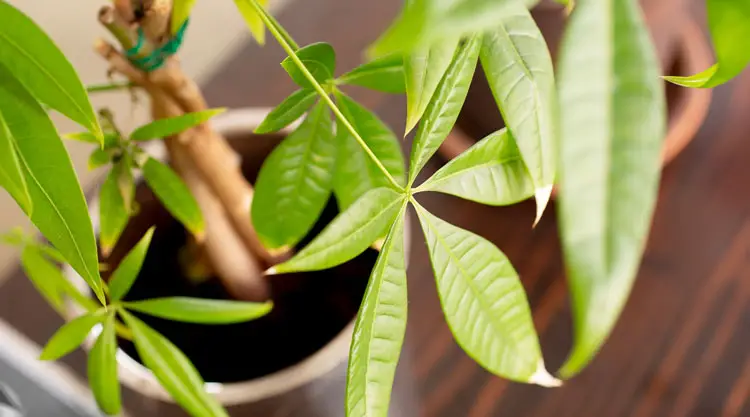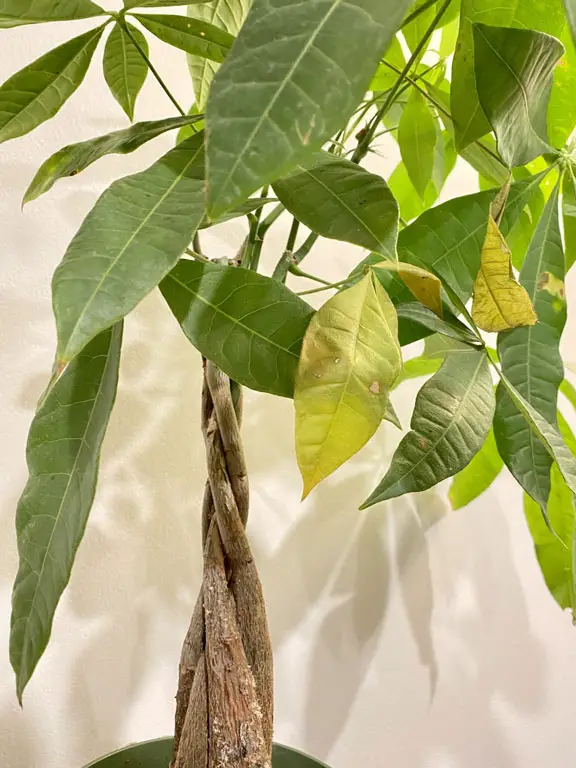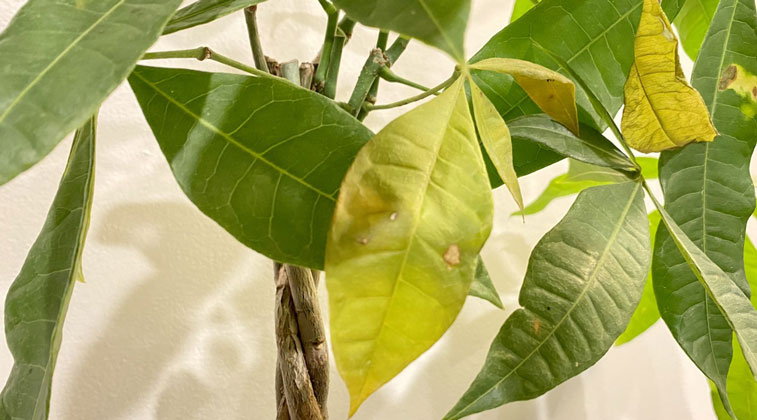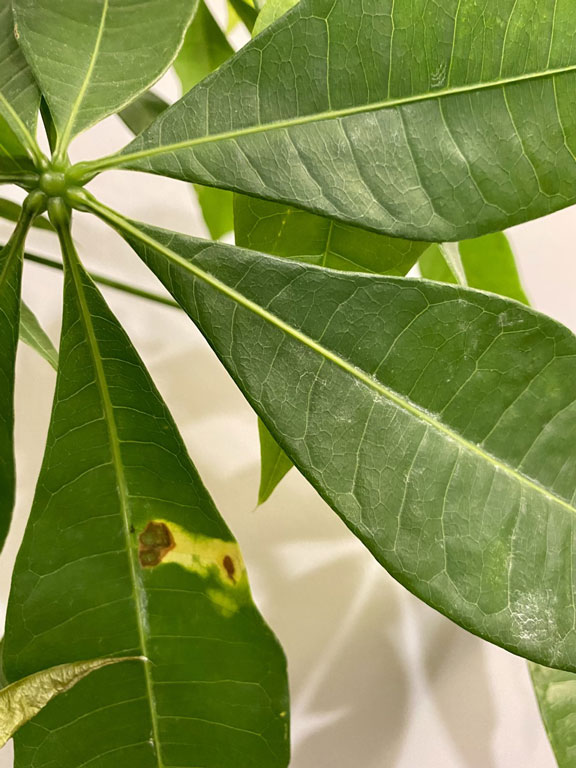How Do You Fix Yellow Leaves on a Money Tree?

This post follows our research editorial guidelines.

A money tree (Pachira aquatica) is meant to bring luck and prosperity to ones home, so you don’t want yellow leaves putting your good fortune at risk. Not only that, but yellow leaves are a sign something has gone wrong with the poor money tree. It’s suffering, and needs some help to get back on the track to good fortune.
“Pachira can be a confusing plant” writes New York Botanical Gardens Plant Expert Leslie Coleman. “It’s low in care needs and can endure a range of conditions, but only once you have it in the right spot and establish a routine where the needs of a tropical wetlands plant, for moisture, humidity and light, are respected.”

Table of Contents
Money Trees that are showing signs of yellowing leaves are typically caused by poor growing conditions, watering issues or attacks from pests or disease. Providing consistent care to ensure recovery and a return to glossy, green foliage.
Yellow leaves can show up on a money tree if any part of that care routine isn’t right for what it needs. As a result, it’s important to check all the symptoms and be sure you have the right diagnosis before you decide to act.
Leaves Yellow From Over-watering
People see the ‘aquatica’ part of the money tree’s scientific name and go wild with the watering can, much to the money tree’s detriment. Large amounts of stagnant water drown the root system, eventually killing them outright. They are no longer able to provide the money tree with the support it needs, and the leaves start to yellow in response.
Other signs of over-watering include soggy, stinking soils, leaf drop, and occasionally soft, wet blisters that pop when pressed. This is oedema, a classic sign of over-watering.
How to Fix Over-watered Money Tree

If the damage is mild, allow the over-watered money tree to dry out. Empty any drip trays or saucers of standing water and allow the soil to dry out completely before watering again. But if there’s the potting mix smells foul, or the money tree feels loose in the pot, you might have root rot, with more drastic action required.
Tap the plant from its pot gently and examine the roots. Healthy roots are pale, and smell like the soil around them. If the roots are discolored, slimy or disintegrate when touched, they are dead. You’ll need to trim away any rotten material, rinse the roots and re-pot your money tree in a new pot of fresh soil. There’s more detail on how to re-pot a money tree here.
In future only water your money tree when the top two inches of soil are dry.
Leaves yellow from Under-watering
Confusingly, yellow leaves are also a sign of under-watering. With no water available in the soil, the leaves begin to dry out. If not treated in time, they will die of thirst, turning yellow and then a crisp, desiccated brown.
Look out for wilted and curled leaves, drooping stems, and leaf drop. The pot will also have crumby, dry soil and be unusually light when lifted.
How to fix an Under-watered Money Tree
Give your poor money tree a really deep drink. While watering the soil from above is fine, I I like to water a dehydrated plant from below.
To do this:
- Remove the money tree from its saucer or drip tray
- Place the plant in a tub or basin and fill clean water to half the height of the pot.
- Let the money tree soak for a half hour, topping up the water level as required
- Remove the plant and allow the pot to drain completely before returning the money tree to its spot
This technique delivers water directly to the roots, and will revive even the most aggressively dry soil. I go into more detail about how to best water a money tree here, but in short its a lot of good clean water, given only when the top two inches of soil are dry.

Leaves Turning Yellow from Poor Soil Quality
When we think about watering, quantity and frequency are usually what we consider. But just as important is the quality of the money tree’s soil. How that soil responds to watering will change how much moisture a money tree has at its disposal.
Soil that is heavy and that drains poorly will hold too much water, and may lead to root rot. Conversely, those with too little organic matter won’t hold that water for long enough to enable the money tree to use it at all.
How to Fix Poor Soil Quality for Money Tree
Money trees need a soil that holds moisture but allows the excess to flow freely away. The best way to achieve this is to blend your own! This will allow you to precisely control the properties in the soil and give the money tree exactly what it needs.
I use a good quality potting soil mixed with equal parts perlite and an organic element like coco coir or sphagnum moss. The perlite provides good flow through and pockets of air for the roots, and the organic elements retain just the right amount of moisture. If perlite is hard to come by, light river sand is a decent substitute.
I write a bit more about blending soils for money trees here. It’s also critical you put that soil in a good quality pot – one with at least three drainage holes is a must.
Leaves yellow From Lack of Light
Money trees love lots of bright, indirect light. Without enough, they’ll struggle to survive let alone grow new foliage. The leaves produced while under inadequate light will be smaller, more fragile, and prone to yellowing.
Other signs of low light include legginess and a tendency to lean towards the light source. Growth will be overall quite poor, with few new leaves and those sparsely positioned.
How to Fix Lack of Light for a Money Tree
Relocate your money tree to an area with that will provide a full day of bright, indirect light. A southern or south-eastern facing room is ideal. Avoid direct sun, as this can scald their delicate leaves.
Money trees don’t like being relocated, it must be said. It’s likely to throw a tantrum in the form of lost leaves. But in the long run your plant will be far better off with the light it needs to replace them.
Leaves yellow From Disease
While they don’t often get sick, soil born pathogens sometimes infect money trees. Worst of these is Phytophthora, a persistent agricultural disease that causes billions of dollars worth of damage each year.
Diseased leaves may start with yellow patches that develop welts, weals or crusty, scabby areas. They also have a habit of spreading from plant to plant, so if you find similar blotches on other parts of your collection, it’s likely disease is your problem.
How to Fix a Sick Money Tree
Immediately quarantine any sick or diseased plants – your money tree may well be just one victim of many, so be sure to check the rest of your collection.
Next, use sterile scissors or shears to remove affected leaves. Toss them in the trash, as composting sick leaves will contaminate your compost and allow disease to spread.
Water thoroughly and place the money tree in an appropriately lit area away from the rest of the collection. If you are treating a particularly treasured specimen, it may be worth applying a broad spectrum anti-fungal and antibacterial plant medicine. Always pay attention to the instructions, as these sorts of treatments tend to be quite strong and can cause damage if used incorrectly.

Leaves Yellow from Pest Damage
Money trees are a valuable food plant in much of their natural range, and garden pests also find them irresistible. While most pests with take a nibble, scale bugs and spider mites are the two to really watch for.
Scale bugs are shield shaped pests no larger than a small sequin. They suck sap, and love to cluster in the crevices between leaves and around veins.
Spider mites are small red flecks, sometimes maroon or even pink. They’re so small you might spot their webs, first – a fine silvery thread like cotton candy, strung between the junctions of leaves and branches. They too suck sap, and will drain the life right from the leaf.
Yellow patches towards the tips of leaves signal some tiny insect vampire has their fangs into a vein, starving the rest of the leaf. Soon it yellows and dies. Other signs include specking, thin patches of leaf, or holes and lacy nibbled edges.
How to Fix Pest Damage on a Money Tree
Much like disease, it’s critical to quarantine any money tree found to have pests. They love to spread from plant to plant.
If you catch it early enough, you can remove the pests by hand. I like to brush them with a q-tip dipped in a bit of rubbing alcohol. The alcohol does double duty in sterilizing the wound on the plant and drying out the bug in question, killing them before they can climb back onto my plant.
But larger infestations need more serious treatment. Neem oil leaf spray is a good all-rounder, applied to the plant weekly until the creepy crawlies disappear. Systemic granules are a long term solution for larger collections.

Leaves yellow from Infertile Soil
A money tree must take all its nutrition from the soil in its pot, and when that soil lacks fertility it will impact the quality of the leaves. Infertile soil lacks the vital nitrogen and micro-nutrients can lead to chlorosis, a condition wherein even the most radiant of leaves loses their color.
The pH of the potting mix is also important – a blend that is too alkaline will prevent the money tree from accessing available nutrients, locking them to the soil in a way the plant can’t access.
How to Fix Infertile Soil for a Money Tree
Fertilize a money tree by adding a half strength dose of balanced liquid fertilizer when watering, no more than twice a month during the spring and summer. I like to use a fertilizer with added fish and seaweed to really make sure all those vital micro-nutrients are included in the mix.
If you’re worried about alkaline soils, your best bet is to ensure the mix has a generous dose of organic material like coco coir or sphagnum moss. The gradual decomposition of organic matter adds a gentle level of acid to the soil, and will ensure it stays at just the right pH.
Leaves yellow From Transplanting
Re-potting and transplanting is always tough on the money tree’s roots, as even the most tender of touch will still result in damage to this most delicate of systems. Once injured, it will take the money tree time to heal, and until then the leaves will struggle to get what they need to thrive.
If you’ve recently re-potted your money tree, those yellow leaves are a sign the roots did not make it through the process intact. Other symptoms include wilting and the shedding of leaves.
How to Fix Transplant Shock in a Money Tree
There’s no magic fix here but to wait. The Money tree will recover on its own if provided with gentle, consistent care. Keep it at warm and stable temperatures with the same light levels and water that it usually receives. After a week or two it should spring back.
Natural Reasons Money Leaves Turn Yellow
It’s not all doom and gloom for your money tree if it starts developing yellow leaves. There’s a few harmless, natural reasons for those leaves to change.
Old Age
Old leaves are often the first to change color in times of stress, and they sometimes change color for no other reason than their natural life cycle. If the yellow leaf is part of the lower, older part of the plant, and the other leaves on the same branch are also yellowing, it may simply be that its time has come. You can trim it away if you like with no harm at all to the money tree. It has, after all, already declared that it’s time for that leaf to go.
Seasonal Change
Like many true tropicals, the money tree doesn’t shed its leaves for the winter, but it’s not above getting rid of some of the older ones as the days grow short. As with older leaves, there’s no harm in hurrying that process along by just lopping off the leaves as they yellow. Once the spring comes the money tree will flush with new growth, and you’ll hardly notice their absence at all.
Final thoughts
The best cure for yellow leaves in money trees is to just prevent them from showing up in the first place. By now you’ll have noticed that a lot of yellowing is caused by problems with the money tree’s care regime. By giving it what it needs before it knows it needs it, you can ensure that lush perky foliage stays in top condition.
